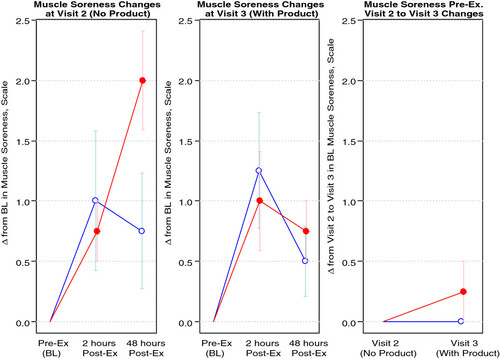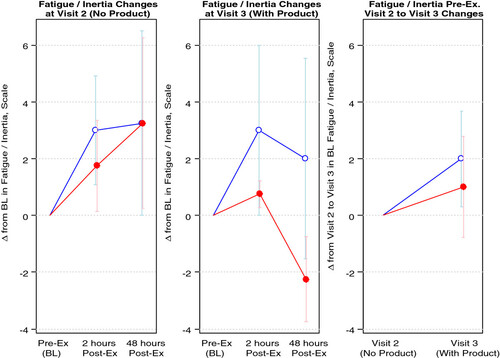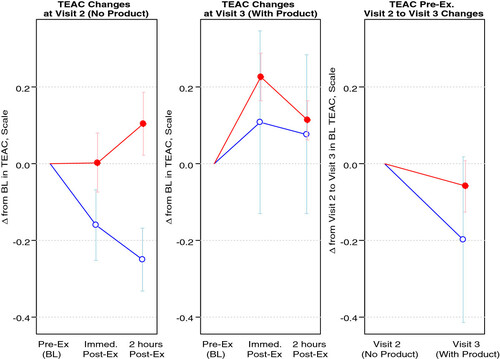Figures & data
Table 1 Characteristics of 8 healthy men assigned to MSM
Table 2 Metabolic panel and blood counts of 8 healthy men assigned to MSM
Table 3 Study timeline and outcome measures
Figure 1 Muscle soreness of 8 healthy men assigned to MSM. Blue Open Circle = 1.5 grams/day; Red Filled Circle = 3.0 grams/day. Data are presented as change from baseline (Δ from BL) on y-axis; Visit 2 is pre intervention (prior to MSM supplementation), Visit 3 is post intervention (following MSM supplementation); Visit 1 included the screening visit. Note: There were statistically significant increases in muscle soreness with and without MSM at the two hour post-exercise time (p= 0.021 and p=0.007, respectively); The 1.5 grams/day group experienced a 0.5 point greater reduction in muscle soreness during Visit 3 (post intervention) as compared to Visit 2 (pre intervention), and the 3.0 grams/day group experienced a 1.5 point greater reduction in soreness during Visit 3 as compared to Visit 2. This 1.0 point difference in baseline-adjusted muscle soreness from two hours post-exercise to 48 hours post-exercise approached statistical significance (p=0.080), suggesting a dose-related improvement.

Figure 2 Fatigue of 8 healthy men assigned to MSM. Blue Open Circle = 1.5 grams/day; Red Filled Circle = 3.0 grams/day. Data are presented as change from baseline (Δ from BL) on y-axis; Visit 2 is pre intervention (prior to MSM supplementation), Visit 3 is post intervention (following MSM supplementation); Visit 1 included the screening visit. Note: All subjects experienced an increase in fatigue that trended towards significance two hours post-exercise at Visit 2 (pre intervention; p=0.084), whereas there was no trend at Visit 3 (post intervention; p=0.181); At Visit 2, subjects’ fatigue scores increased between two and 48 hours post-exercise, but not significantly (p=0.47), whereas at Visit 3, subjects fatigue scores decreased between two and 48 hours post-exercise, but not significantly (p=0.336); the difference in these changes between Visits 2 and 3 trended toward statistical significance (for the 3.0 grams/day group [p=0.073] and for all subjects [p=0.087]).

Figure 3 Blood homocysteine of 8 healthy men assigned to MSM. Blue Open Circle = 1.5 grams/day; Red Filled Circle = 3.0 grams/day. Data are presented as change from baseline (Δ from BL) on y-axis; Visit 2 is pre intervention (prior to MSM supplementation), Visit 3 is post intervention (following MSM supplementation); Visit 1 included the screening visit. Note: At Visit 2 (pre intervention), homocysteine levels were either unchanged or increased slightly immediately post-exercise, whereas at Visit 3 (post intervention), homocysteine levels decreased significantly in all subjects post-exercise (p= 0.007) and trended towards significance in the 3.0 grams/day group (p=0.056).

Figure 4 Blood TEAC of 8 healthy men assigned to MSM. Blue Open Circle = 1.5 grams/day; Red Filled Circle = 3.0 grams/day. Data are presented as change from baseline (Δ from BL) on y-axis; Visit 2 is pre intervention (prior to MSM supplementation), Visit 3 is post intervention (following MSM supplementation); Visit 1 included the screening visit. Note: There was a statistically significant increase in TEAC immediately post-exercise at Visit 3 (post intervention) for the 3.0 grams/day group (p=0.035). TEAC: Trolox Equivalent Antioxidant Capacity.
